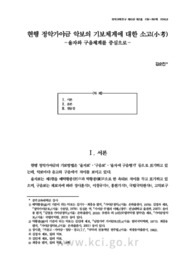

-
미리보기
서지정보
· 발행기관 : 한국국악교육연구학회
· 수록지 정보 : 국악교육연구 / 10권 / 2호 / 239 ~ 262페이지
· 저자명 : 김순진
초록
현행 정악가야금의 기보방법은 ‘율자보’․‘구음보’․‘율자에 구음병기’ 등으로 표기하고 있는데, 악보마다 음고와 구음에서 차이를 보이고 있다. 율자보는 제1현을 배탁황종(㣴)과 탁황종(僙)으로 한 옥타브가 차이 나게 표기하고 있으며, 구음보는 채보자의 주관적인 기준에 따라 조금씩 다르게 전승되고 있다. 이와 같은 현상은 스승에게 전수를 받아 답습하는 전문 연주자들에게는 큰 문제가 되지는 않을 것이다. 그러나 통일되지 않은 악보는 학급별 수업으로 진행되는 학교 음악교육에서는 악곡을 이해하고 습득하는데 여러 가지 문제점이 수반될 것이다.
이러한 점에서 정악가야금과 양금의 율자체계를 살펴 본 결과 20세기까지는 두 악기가 동일한 율자체계를 사용하고 있었다. 즉『우의산수』(20세기 초)는 동시대의 『양금 여민락보』․『조선음률보』․『방산한씨금보』 등의 양금보와 같이 제1현의 기준음을 중성황종(黃)으로 표기를 사용하고 있었다. 그러나 『아악부율자보』(1930년대)에 이르러서는 양금은 탁황종(僙)을 기준으로, 가야금 악보는 배탁황종(㣴)을 기준으로 표기하고 있다. 현재의 정악가야금은 『아악부가야금보』 율자체계를 따른 제1현의 배탁황종(㣴) 악보와 『아악부양금보』와 동일한 제1현을 탁황종(僙)으로 기보한 악보로 나뉘어져 있다. 이에 적절한 율자표기를 위해서는 다른 악기, 즉 동일 음역을 가진 양금과 단소․소금 등의 관악기 음고와 율자표기에 맞도록 제1현을 탁황종(僙)으로 표기해야 한다는 결론을 얻었다.
또한 고악보 『동대가야금보』에서는 각 줄과 음고․조성에 따라 구분되는 구음을 사용하고 있었으나, 현행의 구음보는 연주자 또는 채보자에 따라 조금씩 변형하면서 각각 다르게 전승되고 있다. 그러나 나현숙의 『영산회상』은 비교적 고악보의 구음을 따르고 있는데, 제6현의 ‘仲․姑’와 제9현의 ‘南․無’를 구분하지 않고 있다. 또한 연주법으로 사용된 구음에서는 부호 없이는 연주 방법을 구분할 수 없는 단점도 보였다. 따라서 『동대가야금보』와 그 외의 고악보에 나타난 음고와 악조․연주법을 나타낸 구음법을 적용 보완하여 구음만으로도 독립된 악보의 역할을 할 수 있는 표준안을 구안해야 한다는 결론을 얻었다.영어초록
The current musical notation of jeongakgayaguem uses ‘yuljabo’, ‘gueumbo’, and ‘yulja with gueum’ Among these systems, there are discernible differences in pitch and gueum(oral sound). Yuljabo marks the first string as baetakhwangong(㣴) and takhwangong(僙), which results in an octave difference. Guembo has been inherited differently, depending on score collectors who listened and translated into a musical note by their own subjective standard. This situation can not be a big problem for professional players who directly learn from a master . However, ununified musical notes will generate various problems at music classes of school, particularly in understanding and acquiring music.
In this regard, we compared the frame of music notes, yulja system of jenogakgayaguem and that of yangguem. Until early twenty centuries, they used the same notes. 『Woouisansu』 『寓意山水』(Music score), the music note of gayaguem used the same frame of music score 『yanggum yeominlakbo』 『楊琴 與民樂譜』(Music score) and 『pansanhanssigumbo』 『芳山韓氏琴譜』(Music score). That is, based on joongseonghwang(黃), the first string was marked. However, in 『aakbuyuljabo』 『雅樂部律字譜』(Music score) of 1930s, yangguem was written by takhwangong(僙) base and musical notes of gayaguem by baetakhwangong(㣴) base respectively.
Current jenogakgayaguem has two kinds of music score. One follows yulja system of 『aakbugayaguembo』 『雅樂部伽倻琴譜』(Music score) and the other uses the same notation of 『aakbuyanguembo』 『雅樂部洋琴譜』(Music score), which marks the first string as takhwanggong(僙). Based on the comparison, we concluded that the first string should be marked as takhwangong(僙) in order to set up the proper yulja notation and effective education, that matches the pitch and yulja notation of same range instruments such as yangguem and wind instruments (danso, sogeum.and the like).
Moreover, in zncient score 『Tongdaegayaguembo』 『東大伽倻琴譜』, different gueum was used, according to each string, pitch, or key. And the current Guembos have been respectively transformed and passed down differently, depending on an player or score collector.
However, 『yeongsanhoesang』 『靈山會上』(Music score) of Nah, Hyun-Sook follows gueum of old music score, so it does not differentiate gung(仲) and go(姑) of the sixth string and nam(南) and mu(無) of the ninth string. In addition, it contains a shortage in notation of performing method, for it is difficult to differentiate the meaning of gueum without mark.
Therefore, we concluded that it is needed to devise the standard method, which represents an independent music score of gueum exclusively and complements the gueum rule that is used pitch and toneㆍperforming method in 『Tongdaegayaguembo (東大伽倻琴譜: Music score)』 and other old music scores.참고자료
· 없음태그
-
자주묻는질문의 답변을 확인해 주세요

꼭 알아주세요
-
자료의 정보 및 내용의 진실성에 대하여 해피캠퍼스는 보증하지 않으며, 해당 정보 및 게시물 저작권과 기타 법적 책임은 자료 등록자에게 있습니다.
자료 및 게시물 내용의 불법적 이용, 무단 전재∙배포는 금지되어 있습니다.
저작권침해, 명예훼손 등 분쟁 요소 발견 시 고객센터의 저작권침해 신고센터를 이용해 주시기 바랍니다. -
해피캠퍼스는 구매자와 판매자 모두가 만족하는 서비스가 되도록 노력하고 있으며, 아래의 4가지 자료환불 조건을 꼭 확인해주시기 바랍니다.
파일오류 중복자료 저작권 없음 설명과 실제 내용 불일치 파일의 다운로드가 제대로 되지 않거나 파일형식에 맞는 프로그램으로 정상 작동하지 않는 경우 다른 자료와 70% 이상 내용이 일치하는 경우 (중복임을 확인할 수 있는 근거 필요함) 인터넷의 다른 사이트, 연구기관, 학교, 서적 등의 자료를 도용한 경우 자료의 설명과 실제 자료의 내용이 일치하지 않는 경우
“국악교육연구”의 다른 논문도 확인해 보세요!
-
단소 교본 분석을 통한 문제점과 개선방안 38 페이지
단소는 사람들이 처음 접하는 국악기이자 국악의 첫인상이다. 교육과정에서의 단소는 휴대성이 좋으며, 소리가 정서적으로 편안하고 길게 내뱉는 복식호흡을 사용하여 스스로를 조절하는 능력을 키울 수 있다는 장점이 있다. 최근 소리 내기가 어렵고 연습 과정에서 인내심이 필요한 부분에 있어서 상대적으로 쉬운 소금(小芩)으로 대체되는 경향이 있지만, 여전히 단소는 국악.. -
향토민요 복원의 현황 검토와 교육적 의의 및 활용방안-경기도 지역을 중심으로- 32 페이지
자립의 힘을 거의 상실한 향토민요의 현실에서 우리가 소중한 문화유산을 지키기 위해 할 수 있는 일은 무엇일까. 과연 향토민요는 오늘날 삶의 현실에 존재할 수 없는가. 라는 의문에서 출발하여 경기도 향토민요를 중심으로 복원을 위한 선행의 제문제를 검토하고 실제 복원 사례 및 대표적 결과물이라 할 만한 무형문화재의 현황 등을 살펴보았다. 향토민요가 예술작품으로..
문서 초안을 생성해주는 EasyAI

